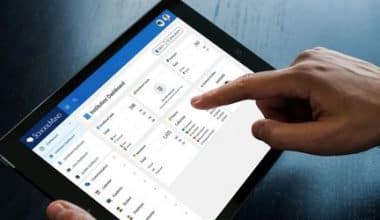Many businesses utilize relational database management systems to carry out routine administrative duties like tracking orders or maintaining inventory levels. In this article, we explain relational database management systems and their examples. To further grasp how it functions, we also examine the relational database model and non-relational databases.
These systems commonly employ the SQL programming language to access and understand data from databases.
What Is a Database?
A database is a collection of data kept on a computer. Most of the time, this data is organized in a way that makes it simple to access.
What Is a Relational Database?
A particular kind of database is a relational one. This is because it makes use of a structure that enables us to recognize and access data in connection to another piece of data in the database. Relational databases frequently use tables to organize data.
What Is Relational Database Management Systems (RDBMS)?
Relational database management systems (RDBMS) are tools that enable you to create, edit and manage relational databases. These systems typically use the SQL language to access databases.
They are utilized in many fields. For instance, manufacturing, human resources, and banking. The system is also helpful for airlines that need to keep track of passenger documents and ticket service information, as well as for colleges that manage student databases.
Advantages of Relational Database Management Systems
Most businesses can benefit from using an RDBMS since the systematic perspective of raw data makes it easier for businesses to comprehend and utilize the information while improving the decision-making process.
The table format RDBMS use is easy to understand as it provides an organizing and structural manner through which firing queries can match entries. Users can limit the available content by setting barriers and customizing access.
Due to this capability, the RDBMS is especially beneficial for businesses where the manager controls which data is available to clients and staff.
Additionally, while guaranteeing consistency with the previously available material, RDBMS makes it simple to add new data to the system or modify existing tables.
Since modifications only need to be made once, updating data is more effective. Updating, controlling, and maintaining data in the database is simple for database administrators. Because the RDBMS automates these processes, backups are also made simpler
Disadvantages of RDMS
There are drawbacks to relational database management systems as well. An RDBMS implementation, for instance, requires the acquisition of specialized software.
Execution will now be more expensive as a result. After purchasing the software, the installation process can be time-consuming due to the need to transfer millions of lines of data into the RDBMS tables.
A programmer or data entry expert may be needed to further assist this process. To ensure that they do not private data to the wrong people, they must take extra caution when entering it.
Other issues with the RDBMS include the character limit imposed on some fields in the tables and its inability to properly comprehend new types of data, such as complex numbers, drawings, and images.
Furthermore, even if isolated databases can be developed using an RDBMS, the procedure necessitates separating sizable amounts of data. It can be extremely challenging to link these substantial data sets to create an isolated database.
Relational Database Management Systems Examples
Some examples of specific systems that use relational database management systems include IBM, Oracle, MySQL, Microsoft SQLServer, and PostgreSQL.
#1. MySQL
MySQL is a relational database management system that is free and open source. It is one of the examples of Relational Database Management Systems that oracle owns. According to the co-founder, Its name is a mix of “My,” the name of co-founder Michael Widenius’s daughter My, and “SQL,” which stands for Structured Query Language.
An RDBMS, in addition to relational databases and SQL, works with an operating system to implement a relational database in a computer’s storage system, manages users, allows for network access, and simplifies verifying database integrity and backup creation. The most common use of MySQL databases is for web databases
Moreover, MySQL is offered under a variety of proprietary licenses and is free and open-source software under the rules of the GNU General Public License.
#2. Oracle Database
This is one of the examples of relational database management systems for enterprise grid computing. It is the most flexible and cost-effective way to manage information and applications.
Oracle Database is a database management system that Oracle Corporation manufactures and markets.
It’s a database that you can use for online transaction processing (OLTP), data warehousing (DW), and mixed (OLTP & DW) workloads. Oracle Database is accessible on-premises, in the cloud, or as a hybrid cloud installation from a variety of service providers. It can run on both third-party and Oracle hardware (Exadata on-premises, Oracle Cloud, or Cloud at Custom).
#3. Microsoft SQL Server
This is one of the examples of relational database management systems Microsoft develops.
As a database server, it is a software product whose principal role is to store and retrieve data as requested by other software applications—which may run on the same computer or on another computer across a network (including the Internet).
Microsoft sells at least a dozen various editions of Microsoft SQL Server, each intended for a different audience and for workloads ranging from modest single-machine applications to huge Internet-facing systems with many daily visitors.
#4. PostgreSQL
It is also an open-source object-relational database system with over 30 years of active development that has earned it a strong reputation for reliability, feature robustness, and performance.
PostgreSQL is a free and open-source relational database management system (RDBMS) that focuses on flexibility and SQL conformance. It was first known as POSTGRES, a reference to its roots as a successor to the Ingres database built at the University of California, Berkeley. To reflect its SQL support, the project was renamed PostgreSQL in 1996. The development team opted to preserve the name PostgreSQL and the alias Postgres after a review in 2007.
Transactions with Atomicity, Consistency, Isolation, and Durability (ACID) attributes are available in PostgreSQL, as are automatically updatable views, materialized views, triggers, foreign keys, and stored procedures.
Its function is to manage a wide range of workloads, from single computers to data warehouses or Web services with a large number of concurrent users. It is the default database for macOS Serve and is also available for Windows, Linux, FreeBSD, and OpenBSD. It is one of the examples of relational database management systems.
#5. SQLite
SQLite is a database engine, and it is a C programming language that implements it. It is not a separate program; rather, it is a library that software developers incorporate into their applications. As such, it belongs to the family of embedded databases. It is the most commonly used database engine, as a lot of the top web browsers, operating systems, mobile phones, and other embedded systems use it.
SQLite supports connectors for several computer languages. It generally adheres to PostgreSQL syntax but does not impose type checking by default. For instance, you can insert a string into a column. This is one of the examples of relational management systems.
#6. MariaDB
It is one of the popular open relational databases initially designed by the developers of MySQL developers. It is popular for its performance, stability, and openness(open-source).
The MySQL relational database management system (RDBMS) has been forked into MariaDB by the community, with the intention of keeping it free and open-source software under the GNU General Public License. Some of the original MySQL developers, who forked it in 2009 amid worries about its acquisition by Oracle Corporation, are in charge of development.
You can use MariaDB as a drop-in replacement for MySQL. These features include library binary parity, perfect matching with MySQL APIs and commands, and other features designed to retain high compatibility with MySQL. Although New features are diverging. New storage engines like Aria, ColumnStore, and MyRocks are part of it.
Michael “Monty” Widenius, one of the founders of MySQL AB and Monty Program AB, is its chief technology officer and lead developer. This is one of the examples of relational database management systems.
Relational Database Model
The relational database model (RM) is a method for organizing data that adheres to a structure and language consistent with first-order predicate logic. It was around 1969 when English computer scientist Edgar F. Codd first introduced it. But In the relational model, all data is represented as tuples that are then arranged into relations.
The goal of the relational database model is to offer a declarative method for specifying data and queries. Therefore, users can directly state what information the database contains and what information they want from it. Moreover, this leaves the database management system software to describe data structures for storing the data and retrieval procedures for responding to queries.
What Is a Relational Database?
The term “relational database” refers to a particular kind of database that stores and makes available connected data items. Moreover, the relational model is an easy-to-understand method of representing data in tables.
Each row in a table is a record in a relational database, and the key identifies each record individually. the table’s columns store the attributes of the data, and since each record typically has a value for each attribute, it is simple to determine the associations between data points.
A brief description of the relational model is as follows:
- Any given row of the relation indicates a character, i.e., the row of the table describes a real-world entity.
- The columns of the table indicate the attributes related to the entity. In this case, the roll number, CGPA, and the name of the student.
Features of a Relational Database Model
Since a relational database is based on the relational model, the database consists of various components based on the relational model. These include:
- Relation: A two-dimensional table can store a collection of data elements.
- Tuple: Row of the relations, depicting a real-world entity.
- Attribute: Column of the relation, depicting properties that define the relation.
- Attribute Domain: it describes the legal values that an attribute can take.
- Degree: This is the total number of attributes present in the relation.
- Cardinality: It specifies the number of rows present in the relation.
- Relational Schema: It is the logical blueprint of the relation.
Advantages of using the relational Database Model
- Storing data in tables is much easier to understand and implement as compared to other storage techniques.
- Because of the independent nature of each relation in a relational database, it is easy to manipulate and manage. This improves the performance of the database.
- With the introduction of relational algebra, relational databases provide easy access to data via high-level query language like SQL.
- With the introduction and implementation of relational constraints, the relational model can maintain data integrity in the database.
Disadvantages of using the relational model
- The performance of the relational model depends upon the number of relations present in the database.
- Hence, as the number of tables increases, the requirement for physical memory also increases.
- The structure becomes complex and there is a decrease in the response time for the queries.
- Because of all these factors, the cost of implementing relational database increases.
Non-Relational Databases
In contrast to conventional relational databases, non-relational databases (often referred to as NoSQL databases) store their data in a non-tabular format. Moreover, non-relational databases use data structures like documents. Despite carrying a variety of different sorts of information in various formats, a document can be comprehensive. Non-relational databases are far more flexible than relational databases due to their capacity to process and organize numerous types of information concurrently. Examples of non-relational databases are MongoDB, Apache, Cassandra, Redis, Couchbase, Neo4.
What are Non- Relational Databases?
For instance, a sizable retailer might maintain a database with individual documents for each client, each of which contains all of the customer’s personal data, including name, address, order history, and credit card details. Each of these pieces of information can be kept in the same document even though their forms are different.
Because a query in a non-relational database doesn’t frequently require viewing multiple tables to produce a response like one does in a relational database, they frequently operate more quickly. Because of this, non-relational databases are perfect for applications that work with a variety of data types or for storing data that updates regularly. They are also capable of supporting quickly evolving applications that need a dynamic database. It is swiftly adaptable and able to handle vast amounts of complex, unstructured data.
When beginning a project, it is important to consider the distinctions between relational and non-relational databases. to better comprehend the project’s ideal solution. Additionally, think of several instances in which you would desire to use one over the other and distinct examples of both possible applications.
The Benefits of Non-Relational Databases
Non-relational databases are able to store enormous amounts of data, as well as query these data sets with ease.
These databases can scale to accommodate any sort of data while yet remaining affordable. Non-relational databases are fast.
Unlike relational databases, which can only store data in a structured manner, these types of databases can store both structured and unstructured data.
Disadvantages of Non-Relational Databases
Due to NoSQL’s BASE architecture, ACID transactions are not guaranteed (Basically Available, Soft State, Eventual Consistency).
Backup: A drawback of non-relational databases is the lack of a backup for these kinds of databases.
Although MongoDB has some backup options, they fall short of expectations. NoSQL databases can not obtain a reliable backup.
There are no set standards for databases in NoSQL databases. There is no standard method to access the data in NoSQL databases because the design and query language differ from one to the next,
What are the 4 Types of DBMS?
The types of DBMS based on data model are as follows −
- Relational database.
- Object-oriented database.
- Hierarchical database.
- Network database.
What are the Four 4 Major Characteristics of RDBMS?
Traditional databases/RDBMS have ACID properties – Atomicity, Consistency, Isolation, and Durability
- The establishment of an index to aid in the retrieval of material at a faster rate.
- Allows for the sharing of a common column across two or more tables.
- Individual users have the ability to control multi-user accessibility.
- To store sensitive data and ease queries, You can create a virtual table.
What are the Advantages of a Relational Database Management System?
- It classifies data
- it is very Accurate
- The simplicity of use.
- Functioning cooperatively.
- Security
Why is it Called a Relational Database?
A relational database is a database that uses rows and columns to store data in a structured way. In the database, this makes it simple to find and access particular values. The values in each table have relationships with one another, making it “relational.” Moreover, tables may be connected to other tables.
What are the Limitations of a Relational Database?
- Maintenance Problem.
- Cost.
- Physical Storage.
- Lack of Scalability.
- Complexity in Structure.
- Decrease in performance over time.
What are the Problems with Relational Databases?
Although they bear the moniker “relational,” relational databases do not maintain relationships between data items, making them inappropriate for the heavily connected data of today. Due to the rigid structure of relational databases, they are not very flexible
Conclusion
Furthermore, this is a group of tools and features that let IT teams and other users create, update, maintain, and work with relational databases in other ways. Most commercial relational database management systems (RDBMSes) use Structured Query Language (SQL) to access the databases, which stores as tables in RDBMSes.
FAQs
What are data types used in RDBMS?
DBMS data types include integer, float, characters, strings, and arrays. They’re also very distinct types, such as dates, date timestamps, boolean, and varchar form
What is a primary key in DBMS?
The column or columns that each row in a table uses to uniquely identify itself is known as the primary key. In a database table, there must be
What are the types of keys?
- Primary Key.
- Super Key.
- Candidate Key.
- Alternate Key.
- Foreign Key.
- Composite Key.
- Unique Key.
What is Normalisation?
Data in a database are arranged by a process called normalization. In order to secure the data and increase the database’s flexibility by removing redundancy and inconsistent reliance, this entails constructing tables and defining relationships between those tables in accordance with rules.
References
- http://sqlite.org/index.htmlsqlite.org/index.html
- http://microsoft.com/en-us/sql-server/sql-server-downloadsmicrosoft.com/en-us/sql-server/sql-server-downloads


![Daily Planner: Best Free Apps to Install in 2023[IPHONE & Android]](https://businessyield.com/wp-content/uploads/2023/04/plann-380x220.png)



